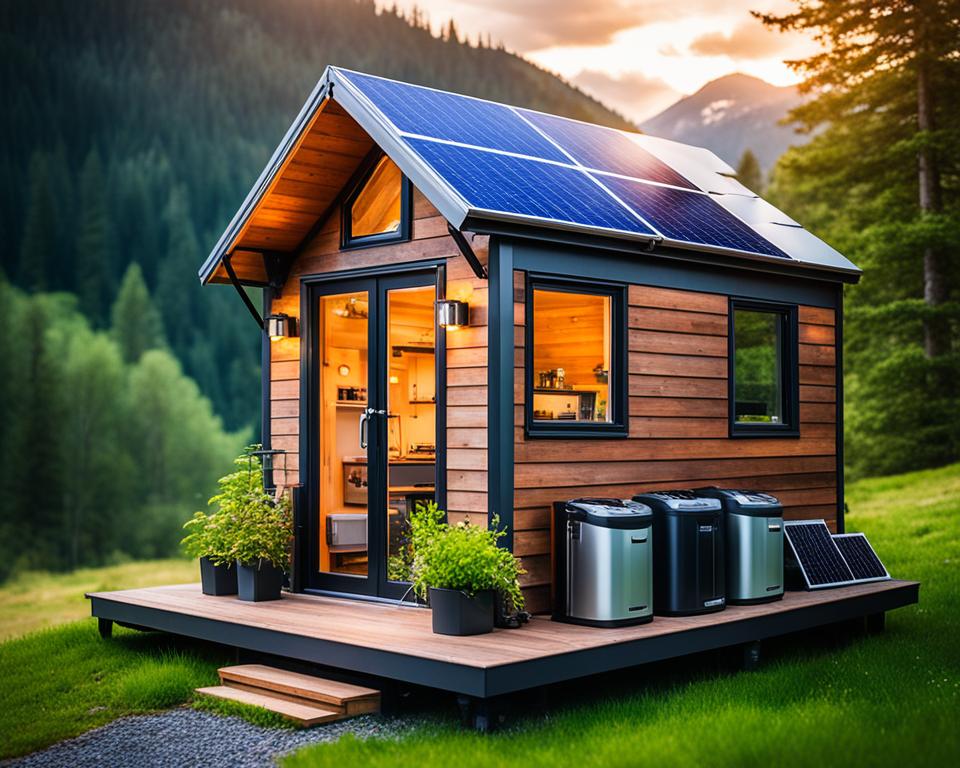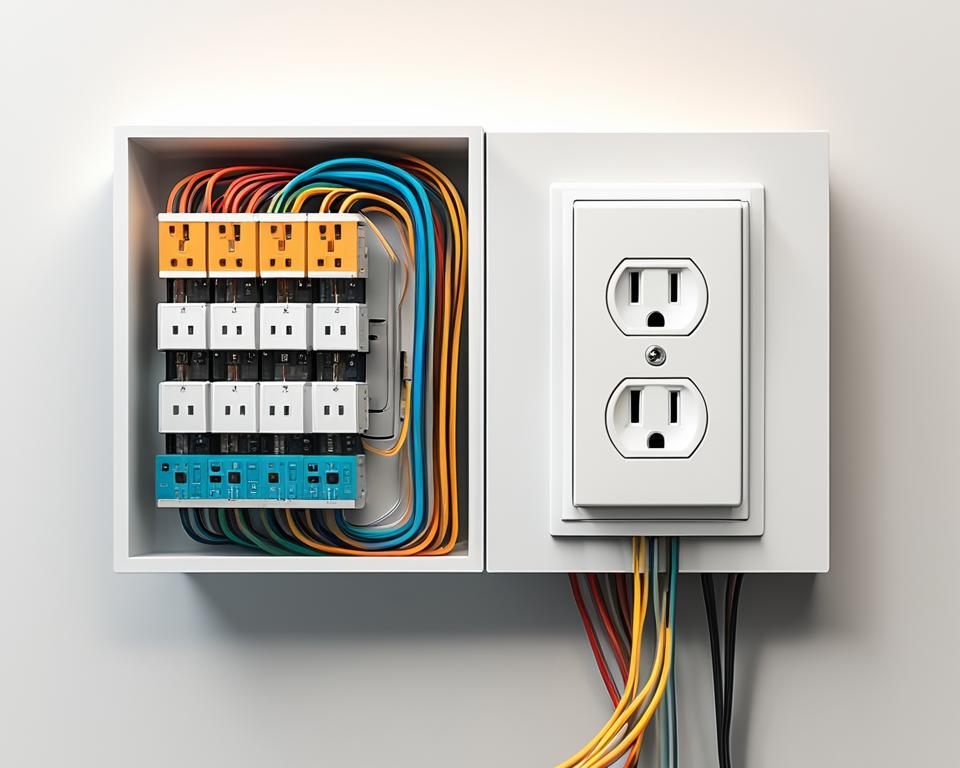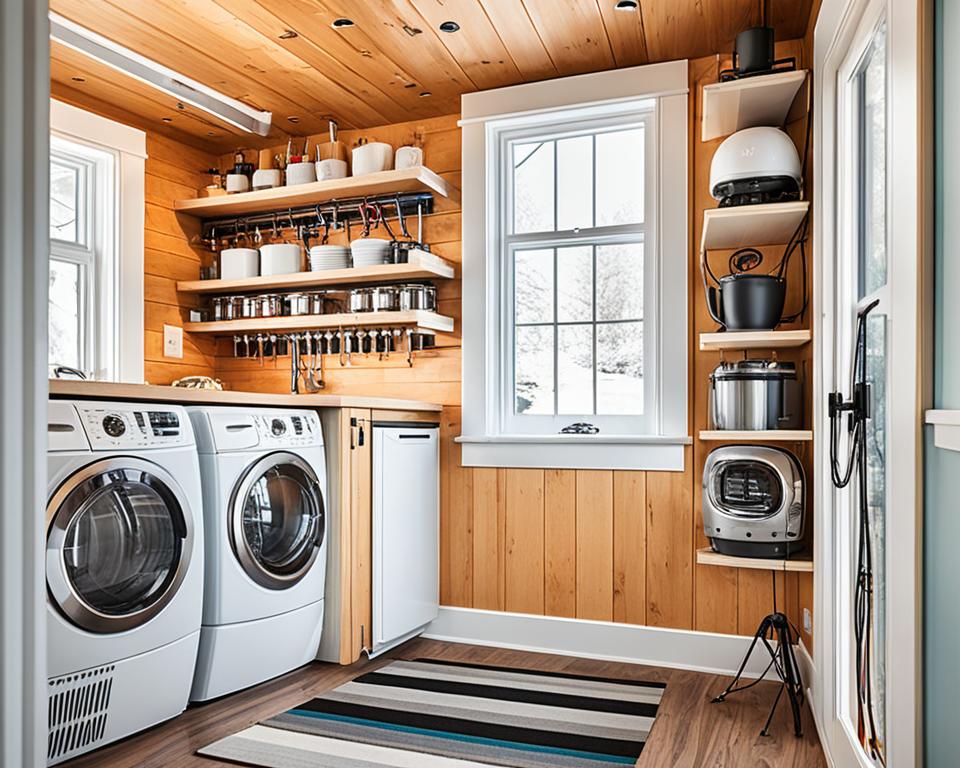Imagine living in a home with just 225 square feet. Yet, such compact spaces demand a robust electrical system, tailored for their specific constraints and requirements. This is where our tiny house electrical guide shines. We offer essential tips for smart wiring for tiny homes. Our goal is to ensure your small living space has modern conveniences, without any drawbacks.
The era of large, costly, and environmentally taxing homes is behind us. Choosing a minimalist life doesn’t mean sacrificing technology or comfort. It’s about integrating minimalist home power solutions that efficiently utilize every inch. Let’s explore the complex world of wiring for small spaces together, lighting up your tiny house dream.
Understanding the Basics of Tiny House Electrical Systems
Electrifying your tiny home is a thrilling move towards sustainability, yet it demands knowing the compact house electrical system basics. Before exploring the essential elements of tiny home wiring solutions, let’s ponder what sets the tiny home electrical system apart.
Key Components of Small Space Wiring
The essence of any electrical system is its components. In tiny homes, the importance of efficiency and size can’t be overstated. From circuit breakers to wiring and outlets, each plays a vital role. Circuit breakers safeguard your home against overloads, correct wiring ensures safe electricity flow, and well-placed outlets offer access to power. These elements must be adapted and chosen with a tiny home’s unique needs in mind.
For a closer examination, here are the small space electrical components frequently seen in tiny homes:
- Circuit Breakers: They act as a safety shield, stopping electrical fires by cutting off when a circuit overloads.
- Wiring: Tiny homes often use multi-strand wires for their flexibility and durability.
- Outlets and Switches: Designed to save space and maintain tiny homes’ minimalist look.
Differences Between Traditional and Tiny Home Electricity Needs
The electricity demands of tiny homes stand in contrast to those of traditional homes. Their scale is significantly smaller, requiring a specialized approach to electrical systems. Tiny homes focus on minimal energy use and peak efficiency. Strategies may include selecting low-power appliances, tapping into renewable energy, and finding creative ways to use space efficiently.
Meanwhile, traditional homes enjoy more space and a greater power supply, shaping very different electrical systems.
Common Electrical Terms Explained
To keep us aligned, let’s define some common electrical terms you might encounter:
| Term | Definition |
|---|---|
| Amperage (Amp) | The intensity of an electrical current, measured in amperes. |
| Voltage (Volt) | It’s the electrical potential difference that propels the current. |
| Wattage (Watt) | This measures energy transfer, quantified by one ampere flowing under one volt’s force. |
| AC/DC | Alternating Current/Direct Current – The kind of electric current in homes versus that in batteries and solar panels. |
With these terms clarified, you’re better prepared to grasp the electrical system of your tiny house and make knowledgeable choices for your tiny home wiring solutions. Our goal is to establish a base for a system that not only meets your energetic demands but does so efficiently and sustainably.
Designing Your Tiny House Electrical Plan
Embarking on tiny house electrical system planning is an adventure in optimization and foresight. In sketching blueprints for our compact homes, efficient tiny home wiring design emerges as a critical aspect. We carefully plan outlet placements, light fixture positions, and appliance integrations—both standard and high-capacity.
The beauty of tiny house electrical system planning lies in our need anticipation, within limited space. Our mantra, “measure twice, cut once,” leaves no room for mistakes. Such strategic planning crafts wiring pathways that don’t interfere with living areas but ensure functionality where necessary.
Choosing appliances involves a balance between wants and needs. By focusing on energy efficiency, we select appliances that meet our needs within efficient tiny home wiring design. This approach helps us use our resources wisely:
Our design philosophy of efficiency and precision fosters a clutter-free, sleek environment, embodying tiny home living.
- The layouts facilitate natural movement, with electrical fixtures that are discreet yet accessible.
- Outlet placements are thoughtfully chosen, serving multiple purposes in areas to avoid extra cords and keep the space tidy.
- Light fixtures are not only functional but also enhance the home’s ambiance and design.
We always follow building codes and safety standards in our designs. Thus, our tiny homes are safe havens as well as enchanting dwellings. Let’s celebrate the precision leading us to tranquil and lively tiny house living.
Choosing the Right Materials for Tiny Home Wiring Solutions
When outfitting your tiny home, selecting the perfect tiny home wiring materials is essential. It ensures safety, efficiency, and durability of your electrical systems. It’s about finding materials that enhance your compact living space’s functionality.
Wire Types and Gauges for Compact Living
Choosing the right wire types and gauges is critical in tiny homes due to space constraints. Copper wiring is advised for its superior conductivity and long life. The choice of gauge depends on the wire’s intended use — thicker for appliances, thinner for lights. This consideration ensures your tiny home’s electrical system performs well without compromise.
The Importance of Quality Electrical Panels in Tiny Homes
The electrical panel is crucial in any tiny home. It’s where ‘good things come in small packages’ truly applies. Essential is a compact, high-quality panel that meets energy needs while conserving space. Such panels should allow easy maintenance and be adaptable to future technological or lifestyle changes.
Installing Off-Grid Electricity in Your Tiny House

Adopting off-grid electricity for tiny houses marks a move towards both energy autonomy and environmental stewardship. It involves exploring effective methods to generate and store electricity, guaranteeing a self-sufficient lifestyle in your compact dwelling, wherever it may be situated.
Options for Solar, Wind, and Generator Power
Choosing renewable energy sources is essential for setting up your off-grid tiny house. Solar power in compact homes emerges as a favored option, attributed to its wide availability and consistency. Solar panels capture sunlight, transforming it into usable electricity. However, solar energy isn’t the sole option. Wind turbines provide an alternative renewable source, though they need certain conditions to work well. Generators are a fallback, but picking eco-friendly fuels is crucial to meet sustainability targets.
How to Store Energy with Batteries
For a complete off-grid setup, energy storage solutions are indispensable. Batteries store electricity for times when natural resources like sunlight or wind are scarce. Cutting-edge battery technologies, like lithium-ion and deep-cycle lead-acid, offer extensive storage for the eco-aware tiny house owner.
Managing Energy Consumption
Efficient use and management of energy are crucial for living off-grid. Prioritizing energy efficiency and conscious usage helps reduce overall energy needs. Opting for LED lights, high-efficiency appliances, and being cognizant of peak energy times contributes to lower consumption. Smart devices and energy monitors play a significant role in optimizing your tiny home’s energy usage.
By integrating efficient energy generation, storage, and prudent usage, you can achieve a sustainable lifestyle. Set in any landscape, your eco-friendly tiny house stands as proof. It demonstrates the immense possibilities that come with adopting off-grid solutions in tiny living.
The Art of Smart Wiring in Minimalist Home Power Design
We are champions of efficient, practical living, embracing the task of minimalist home electrical efficiency. The essence is in smart wiring for tiny houses, blending modern solutions with precision and imagination. Our goal? To weave a seamless electric network that integrates perfectly into a tiny home’s decor while ensuring an optimized energy use.
Our approach to electrical simplicity begins with the thoughtful positioning of outlets and switches. This ensures that power use is streamlined, a core aspect of our designs. Envision a habitat free from the clutter of cables sprawling across surfaces. That vision is central to minimalist home electrical design, creating a cleaner, more efficient living space.
- Choosing multi-functional appliances that require fewer power points
- Implementing wireless technology where possible to reduce wiring needs
- Opting for energy-efficient LED lighting that pairs with smart controls
We aim to not only reduce the quantity of wires but to conceal the necessary ones effectively. By rerouting wires behind wall panels or under floors, we foster environments of openness. The adoption of smart home devices elevates this effort, ensuring even small spaces don’t sacrifice modern luxuries.
Smart wiring is not a compromise on luxury; rather, it’s a testament to savvy planning and a commitment to uncluttered living.
In conclusion, mastering smart wiring for tiny houses transcends mere functionality. It forges spaces where technology enhances living without clutter. Thus, a minimalist home electrical system not only functions smoothly but also upholds the philosophy of simplified, efficient living.
Tiny House Electrical: Safety and Building Codes

Choosing the tiny house lifestyle demands prioritization of safety in tiny house electrical systems and understanding of tiny home building codes. This ensures your small residence is not just cozy and efficient, but also secure and compliant with regulations.
Understanding Electrical Codes for Tiny Homes
Abiding by tiny home building codes is mandatory, not optional. These rules exist to mitigate risks and guarantee your tiny home’s electrical framework meets standards. They cover everything from wire sizing to outlet types and the necessary clearance from water sources. Every regulation aims to safeguard occupants.
Tips for Ensuring Safety During and After Installation
Electrical installation in your tiny home requires careful consideration for safety. Here are essential electrical installation safety tips to follow:
- Always deactivate the main power before initiating any electrical task.
- Opt for certified, high-quality materials that comply with local codes.
- Inspect tools and gear regularly to avoid any mishaps.
- Engage a professional electrician for intricate installations.
Installation completion doesn’t mean the end of safety measures. Regular tests and maintenance of your electrical systems are crucial. A reliable circuit breaker and functional smoke detectors are key to preventing emergencies.
| Building Code Requirement | Importance for Safety | Best Practice |
|---|---|---|
| Proper Wire Sizing | Prevents overheating and potential fire hazards | Consult with an electrician or reference the NEC for proper sizes |
| Adequate Circuit Protection | Averts electrical overloads | Place recommended circuit breakers and fuses |
| Correct Outlet and Switch Placement | Reduces risk of electric shock and adds convenience | Adhere to NEC guidelines for proper height and positioning |
| Ground Fault Circuit Interrupter (GFCI) Outlets near Water Sources | Guards against electric shock in moist areas | Put GFCI outlets in bathroom and kitchen locations |
Let these core principles steer you towards a secure and enjoyable tiny house living. Armed with knowledge and dedication to safety, your tiny home will bring the tranquility and comfort you seek.
Maximizing Space with Innovative Tiny House Electrical Solutions
We, as tiny house enthusiasts, acknowledge the necessity of optimizing every inch of our space. Developing space-saving electrical solutions is essential and an art form. We focus on integrating hidden wiring in tiny homes and multifunctional fixtures for compact living. Our goal is to make homes functional and spacious, despite size constraints.
Hidden Wiring Techniques
The quest for clean walls and spacious areas in tiny houses leads to hidden wiring. This method isn’t only about looks; it enhances safety by reducing hazards. Here are some top techniques we use:
- Using furniture to conceal wires and sockets
- Implementing built-in cable management systems in custom shelving
- Fitting electrical tracks within wall cavities for easy access to wiring
Hidden wiring embodies the minimalist spirit of tiny living, matching practicality with design. It marries technology with aesthetics in small spaces.
Multi-functional Electrical Fixtures for Tiny Living
To fully utilize tiny homes, we focus on multifunctional fixtures. These surpass traditional fixtures:
- Combination light fixtures with built-in Bluetooth speakers
- Outlets integrated into home aesthetics, like lighting or appliances
- List itemPop-up electrical sockets that hide when unused
These solutions not only conserve space but bring a modern flair to tiny homes. By choosing these innovative fixtures, we ensure our homes are clutter-free and fully equipped.
Incorporating Smart Home Tech in Tiny House Electrical Systems
The drive for efficient living finds a perfect match in smart home technology for tiny houses. This isn’t simply an upgrade. It’s a game-changer that marries minimalist living with the perks of a tech-savvy environment.
Home automation for minimalist living merges simplicity with innovation. This synergy enhances compact living spaces, making life easier and more connected.
Automating Your Tiny Home for Efficiency and Comfort
Imagine your home responding to you. It customizes temperature, lighting, and entertainment as you walk in. This isn’t fantasy—it’s the reality of smart homes. Devices like smart thermostats, LED lights, and voice control create an eco-friendly, convenient space.
Integrating IoT Devices with Your Electrical Setup
The Internet of Things (IoT) transforms tiny homes into intelligent ecosystems. IoT integration in compact homes enables devices to interact, streamlining daily tasks while saving resources.
Smart plugs, sensors, and cameras boost security and adapt to our habits. They fine-tune energy use, minimizing our ecological impact.
Choosing IoT gadgets that merge seamlessly into your tiny home’s electrical system is crucial. They should enhance your living area without complicating it. Below, a table highlights smart devices that benefit tiny house residents.
| Smart Device | Function | Benefit |
|---|---|---|
| Smart Thermostat | Controls heating and cooling | Energy savings and climate control |
| Smart Lights | Adjustable lighting controls | Reduces power usage, enhances ambiance |
| Smart Plugs | Remote appliance control | Power management and convenience |
| Smart Sensors | Monitor various environmental factors | Increases home safety and energy efficiency |
| Smart Security Cam | Security monitoring | Enhanced security with real-time alerts |
Embedding these technologies into a tiny home enhances life quality. It pushes the boundaries of what’s possible in minimalist dwellings.
DIY or Professional Help: Navigating Tiny House Electrical Installation
Deciding on your tiny house’s electrical system is a big step. You may wonder if following tiny house electrical DIY guidance is enough or if you need professional electrical installation for compact houses. This decision requires you to think about your skills and the equipment necessary. Whether you’re skilled or a novice eager to learn, knowing the work involved is key.
Tackling the project yourself can be fulfilling for those who pay attention to detail and follow rules closely. It involves extensive research, a readiness to learn stuff, and patience. But, it’s crucial to understand your limits. Electrical tasks bring risks, and small mistakes can cause big problems. It’s important to honestly judge your skills before starting alone. Asking for professional help is okay if it means staying safe.
When facing difficult tasks or needing specific knowledge, getting professional electrical installation for compact houses is smart. Experts offer safety and efficiency with their work. They stay informed about current codes and standards necessary for electrical installs. Considering the benefits, hiring a professional can be a smart choice for your small home. Our advice is here to help make your tiny house safe and functional.

